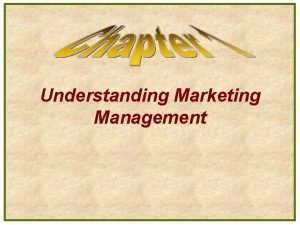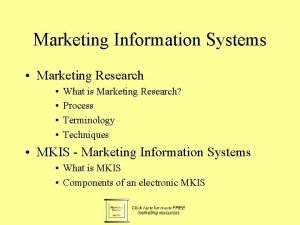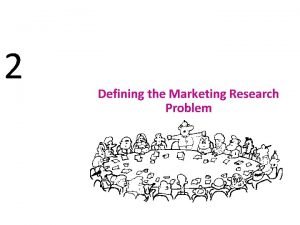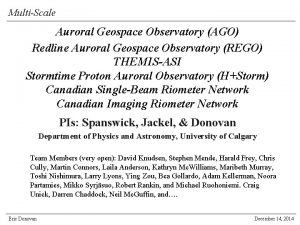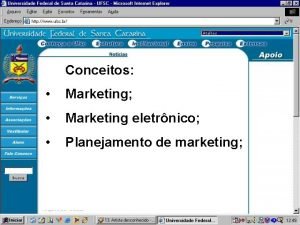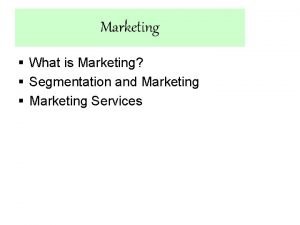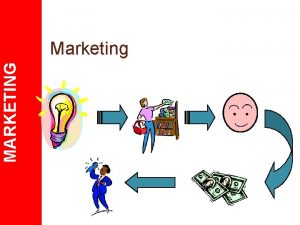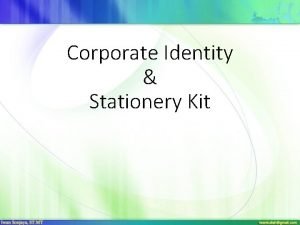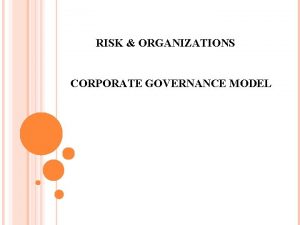Kevin F R Suitor VP Corporate Marketing Redline




































- Slides: 36

Kevin F. R. Suitor VP, Corporate Marketing Redline Communications Inc. Telephone: (905) 948 -2299 ksuitor@redlinecommunications. com Leveraging Wireless Broadband Technologies within the Smart Grid

Legal Disclaimer This documentation is a presentation of general background information about Redline Communications Group Inc. ’s (“Redline”) business and activities current as of the date of this presentation, unless otherwise indicated. It is information in a summary form and does not purport to be complete. Certain statements in this presentation may contain words such as "could", "expects", "may", "anticipates", "believes", "intends", "estimates", "targets", "envisions", "seeks" and other similar language which may constitute forward-looking statements or information under applicable securities legislation. These statements are based on Redline’s current expectations, estimates, forecasts and projections about the operating environment, economies and markets in which Redline operates. These statements are subject to important assumptions, risks and uncertainties, which are difficult to predict and the actual outcome may be materially different. Further, actual results or events could differ materially from those contemplated in forward-looking statements as a result of the following (i) risks and uncertainties relating to Redline’s business including: significant competition, competitive pricing practice, cautious capital spending by customers, industry consolidation, rapidly changing technologies, evolving industry standards, frequent new product introductions and short product life cycles, and other trends and industry characteristics affecting the telecommunications industry; any material adverse affects on Redline’s performance if its expectations regarding market demand for particular products prove to be wrong; any negative developments associated with Redline’s suppliers and contract manufacturing agreements including our reliance on certain suppliers for key components; potential penalties, damages or cancelled customer contracts from failure to meet delivery and installation deadlines and any defects or errors in Redline’s current or planned products; fluctuations in foreign currency exchange rates; potential higher operational and financial risks associated with Redline’s efforts to expand internationally; a failure to protect Redline’s intellectual property rights, or any adverse judgments or settlements arising out of disputes regarding intellectual property; changes in regulation of the wireless industry or other aspects of the industry; any failure to successfully operate or integrate strategic acquisitions, or failure to consummate or succeed with strategic alliances; Redline’s potential inability to attract or retain the personnel necessary to achieve its business objectives or to maintain an effective risk management strategy; (ii) risks and uncertainties relating to Redline’s liquidity, financing arrangements and capital including: any inability of Redline to manage cash flow fluctuations to fund working capital requirements or achieve its business objectives in a timely manner or obtain additional sources of funding; or any negative impact on Redline’s ability to make future acquisitions, raise capital, issue debt and retain employees arising from stock price volatility and any declines in the market price of Redline’s publicly traded securities. Unless otherwise required by applicable securities laws, Redline disclaims any intention or obligation to update or revise any forward-looking statements, whether as a result of new information, future events or otherwise.

Agenda • Introduction • Situation Audit – Business Challenge &Technology Challenges • Wireless and Wi. MAX in the Smart Grid • Applications • Case Study: Hydro One Smart Zone • Conclusion

Why are you at this conference? • I love spending 5 hours in the middle seat travelling from the east coast eating stale peanuts … • I love the vibe of LA, I’m ducking out of here in 30 minutes … • I want to hear from industry experts … • I want to better understand what’s happening with Smart Grids … • I want to talk to my peers about what they are doing – or planning to do … • I want to see what my competition is doing

Who Am I? • 25+ year internetworking industry veteran • Background in: – Telecom; Enterprise Networking; Utilities; Municipal Networking; Military Comms; Transportation – T 1/E 1, SONET, 3270, 5250, Arcnet, Token Ring, Ethernet, ATM, Wi. Fi, Wi. MAX, BWA – Test & Measurement, In-building networking, Metropolitan Area Networking, Wide Area Networking (Wireless, Fiber, Copper, Satellite) • Where do my biases lie? – I believe in the holy trinity of modern communications networks: • Ethernet • IP • ‘NIX – In networking … Use fiber where you can and finish the job with wireless – Wi. MAX and BWI do have a place in the network architects toolbox

Situation Audit Business & Technology Challenges facing Energy Companies and Utilities

Electric Utilities Smart Grid in ARRA 2009 Of the $43 billion appropriation set out for the energy sector in the U. S. stimulus package, roughly $4. 5 billion is aimed at smart grid projects. That $4. 5 billion is in the form of 50 -percent matching grants for a series of regional demonstration projects, as well as regular smart grid investments. Gartner expects more than 150 million smart meters to be installed worldwide in the next five years, with approximately 50% installed in North America.

US Market for Smart Grid Technologies Report ID: EGY 065 A, Published: March 2009, Analyst: Andrew Mc. Williams

By 2014 there will be over 20 million vertical connections in Wi. MAX networks Source: © Senza Fili Consulting LLC

Utility Systems Impacted The Smart Grid strategy must effectively leverage existing functionalities from numerous enterprise systems including: – – – Advanced Metering Infrastructures (AMI); Outage & Restoration Management System Meter Data Management Systems; Control Centre / Energy and Distribution Automation Management Systems; Loss Prevention / Theft Prevention Systems Mobile Workforce / Work Management Systems; Customer Information and Billing Systems; Geographic Information Systems (GIS); Maintenance and Inspection Plan Modeling Applications; Network and Load Analysis Systems; Material Management Systems; and Supply Chain Management Systems.

Requirements for Utilities Source: © Senza Fili Consulting LLC

First Mile Technology Options • • • Wireless Ethernet a safe choice for 1 st mile applications Up to 1 Gbps over 1 km; 100 Mbps over 8 – 10 km Obvious choice for self-build networks for nonincumbents • • • If fiber is available – use it! “Virtually unlimited capacity and distances Cost does not scale with distance; highly variable in urban, suburban and rural deployments • • • Copper possible in limited loop lengths Can achieve up to 500 Mbps over 500 m Opportunity for copper and passive optical network configurations. Good option for incumbent operator with well maintained copper plant •

What do Utilities Need? • High throughput • – GIS‐based applications require transmission of large files. • Low latency and advanced multimedia capabilities – Keep network costs while capacity explodes – reduce $/Mb dramatically – Easy Installation and Maintenance • – Protection & Control, M 2 M, SCADA & Monitoring, Mobile workforce • Qo. S and advanced traffic management capabilities • Secure access to protect the utilities’ communications, and, by extension, the safety of their staff and customers. IP‐based connectivity to facilitate integration of applications with the core IT functions within the utility. – No need for SIM cards • Handoffs to support mobility access, mostly for in‐vehicle and mobile workforce applications. Source: © Senza Fili Consulting LLC Scalability – Support the multiple logical interfaces required for the coexistence of disparate networks throughout the migration times – Utilizing already existing assets – Reasonable upgrade costs – Flexibility to adapt to actual traffic volumes – E. g. deep packet inspection, virtual networks • Cost Efficiency • Transport Quality (BER and Qo. S) – Minimal impact on service quality – Maximal efficiency and flexibility (Adaptive BW) • Transport Reliability (availability) – Reduce service outages – Keep maintenance costs low

Wi. MAX in the Smart Grid

Wireless Technologies Extend the Reach of the Smart Grid • Telecommunications network at the core of the smart grid requires seamless integration of multiple wireline and wireless technologies to transport information between the utility operations center and the network components: – Households and businesses; Vehicles; Staff; Distribution, Transmission, and generation facilities. • The smart grid has to support applications with multiple requirements – Low traffic but extensive coverage needs for smart meters, versus – Very tight latency (<20 msec) for remote control of facilities and assets, and – more limited coverage requirements that rely on a wide range of devices • from meters to remotely controlled video cameras with analytics software • Smart Grids need to operate in all environments – dense urban to the most remote rural areas

Using Wi. MAX to Connect the Smart Grid

High-Level Mobile Wi. MAX Architecture Portal Policy Control Plane (per subscriber) SIP Voice Network Core Service Network (CSN) HA Central Business R 4 R 6 Residential Corporate Aggregation Network MPLS, Ethernet, IP Wi. Fi Mesh Backhaul Mobile user Access Service Network (ASN)

Applications for Utilities

8 Ways Wireless Technologies Enable the Smart Grid? 1. Provide voice and data connectivity to remote workers, their vehicles, and their handheld devices 2. Reach households and businesses in remote areas that lack wireline connectivity 3. Provide utilities with end-to-end ownership and control over their network 4. Enable more extensive asset management (especially for mobile assets, such as service vehicles and trucks) 5. Protect the network and enhance safety and security by remote asset monitoring 6. Monitor equipment to prevent failures or to correct problems as they arise 7. Roll out the network rapidly and with minimum reliance on telecoms carriers 8. Deploy temporary mobile base stations during emergencies and disaster recovery efforts

Applications Supported by Wi. MAX in the Smart Grid Residential customers AMR (Automatic Meter ) / AMI (Automatic Meter Infrastructure) Real-time-ofday pricing using Demand-Side Management (DSM) Home displays In-home energy conservation management Smart appliances Fault and outage detection and management Solar panels management Optional add-ons: Home security Broadband services Generation and distribution Business customers AMR/AMI, industrial metering Remote surveillance and monitoring Remote load shifting Real-time-ofday pricing using DSM Fault and outage detection and management Asset tracking Remote control Energy Management Systems (EMSs) with grid optimization applications (selfhealing, selfrestoration) Mobile assets and remote workforce Supervisory Control And Data Acquisition (SCADA) Distributed Control Systems (DCS) Fault and outage detection and management Remote surveillance and monitoring Fleet telematics and Automatic Vehicle Location (AVL), with Location -Based Services (LBS) supported by Global Positioning System (GPS) Broadband connectivity to invehicle modules, laptops, and handheld devices to support and monitor the remote workforce. Applications include mobile dispatching, reporting, remote video or Vo. IP consultations, data sharing within the utility’s Virtual Private Network (VPN), and Geographic Information System (GIS) applications Emergencies Broadband connectivity to affected area during disaster recovery or in response to faults. Cell On Wheels (COW) connects staff, vehicles, and, in some cases, selected customers Coordination of emergency response, data sharing, remote consultation with off-site staff, and communication and coordination with safety agencies

Electric Utilities Smart Grid Case Study: BB for Smart. ZONE Hydro One Application

Hydro One’s AMI solution architecture is comprised of a two-way self-healing mesh radio network based on the global 2. 4 GHz IEEE 802. 15. 4 standard. The solution provides the flexibility to accommodate cellular, broadband wireless, or fiber WAN backhaul capability. Somewhat unique to AMI deployments, the province has established a centralized Meter Data Management Repository (MDMR) to efficiently serve the needs of all local distribution companies across the province.

Smart Network Applications • Distribution station and security monitoring; • Mobile work dispatch and accomplishment reporting; • Automated vehicle locate safety monitoring; • Emergency management vehicle communications; • Time-of-use rate pilot in combination • with real-time energy monitors; • Automated two-way communicating • home thermostats; and • In-home two-way real-time energy • monitors. Follow on applications include: distribution system automation, outage management, theft detection, remote disconnect, and additional in-home energy management consumer tools

Advanced Metering Infrastructure • Smart Meters/Advanced Metering Infrastructure – Intelligent electronic devices (IEDs) can leverage on AMI’s communication backbone. – Leverage AMI and ODS for outage and asset management • Distribution Transformer Monitoring (DTM) – Install load monitors at distribution transformers, communicate back to data collector through broadband access network; – Enables the monitoring of transformer losses, theft of power, condition monitoring, etc.

Smart Zone Project Partners • Responsible for new systems integration, field services, legacy systems management, integrated process design and operational services • AMI vendor partner, is providing the 2. 4 GHz RF mesh intelligent communications infrastructure, head-end software applications and 1. 3 million smart meters to be installed by Hydro One • GE Energy is supplying smart meters for Hydro One’s smart network project. • Wi. MAX Technology Partner and broadband wireless Ethernet technologies for Hydro One

Conclusions

Why Use Wi. MAX in the Smart Grid? • Versatility— support, in any environment, fixed, portable, and remote connectivity to a wide range of devices, from video cameras to handheld devices. – Redline’s Base stations and SUs can be customized to operate in any licensed or licenseexempt band from 450 MHz to 11 GHz, with any channelization up to 10 MHz, allowing utilities to benefit from Red. MAX in any market in which they operate and leveraging any spectrum available to them. • Carrier-grade performance and reliability— combine high throughput levels (up to 35 Mbps in a 7 MHz channel) with extremely low latency (below 15 msec) and jitter. • Security — Data transmission security is provided by over-the-air encryption with the Advanced Encryption Standard (AES).

Why Use Wi. MAX in the Smart Grid? • Applications support — enable full support for smart grid applications, including those that require Voice over Internet Protocol (Vo. IP), video (uplink and downlink), Virtual Private Network (VPN), and dynamic Quality of Service (Qo. S). – Utilities can optimize the network to host multiple concurrent applications with different requirements to ensure that mission-critical and emergency communications have priority over other traffic, and to establish fine-grained policies for different applications and terminal devices. • Standards-based approach— Wi. MAX is a standards-based approach to technologies that give electric utilities the flexibility to expand their network through time and according to their changing needs. – With its adoption of Orthogonal Frequency Division Multiple Access (OFDMA), Wi. MAX is the most advanced wireless broadband technology commercially available. – Entirely based on IP to allow utilities to benefit from a flatter, less complex network core structure and to facilitate integration with the rest of the smart grid network. • Range— Use Multiple Input Multiple Output (MIMO) technology to extend the base station range. – For PMP links, some base stations have a range of up to 12 miles (20 km) in Line Of Sight (LOS) conditions and of up to 2 miles (3 km) in non-LOS conditions. – For a Point-To-Point (PTP) link in LOS, the range can extend to 28 miles (40 km).

Redline: the ideal BBW platform Technology Ingredients of Next Generation Broadband Wireless: – – – OFDM / OFDMA MIMO, BF All IP Architecture Wide Channel Bandwidth New Spectrum • Redline has core technology DNA and proven platform implementations of this DNA – AN-80 i, Red. MAX 4 C • Engineering team capable of development versus integration

From “Mastering the Hype Cycle” Source: Gartner Group

Q&A


Redline’s Product Suite Redline Management Suite (RMS) & Service Enablement Engine Wireless Infrastructure Fixed and Nomadic Wi. MAX PORTABLE & MOBILE SERVICES Mobile Wi. MAX 3. 3 – 3. 8 / 4. 9 – 5. 85 GHz BWI 3. 3 – 3. 8 GHz 1. 8 / 2. 3 / 2. 5 – 2. 7 / 3. 3 – 3. 8 GHz Red. MAX™ Red. MAX 4 C™ AN-100 UX SU-O / SU-I SC-1000 RRH AN-80 i MAX+ AN-80 i SC-100 e SU-PC REM SU-O SU-I RPM

Redline’s Provides ‘Green’ Solutions • Highest Output Power with Lowest Input Power – SC-1000 with RRH uses less power per Active Radio than a 100 W lightbulb yet covers up to 12 mile cell radius depending on topography and capacity limits – AN-80 i family of hardware is 802. 3 af compliant – draws less than 12 W per system • • Metal enclosures and support brackets are made from Aluminum and Steel and can be easily recycled. The plastic materials used for enclosures are indentified for recycling. Form follows function and all materials are used as sparingly as possible. We only use Ro. HS compliant powder coat finishes. The powder coat process is controlled so that VOC’s (Volatile Organic Compounds) and particulates are not released into the atmosphere. All hardware is Ro. HS compliant. All packaging materials are recyclable and are not bonded to allow recycling.

Our Vertical Markets • Carriers Government Energy Transportation LEC / CLEC / WISP Military / HLS / MUSH Smart. Grid / Oil & Gas Trains / ITS / Light Rail Carriers Military Electric Utilities Smart Grid Transportation / Rail / ITS Between what DSL/CABLE and Fiber can offer • Increase in bandwidth hungry applications like video, internet browsing, and voice over IP strain backhaul infrastructure in Iraq and on domestic bases • Need for scalable solutions to link satellite WAN connectivity at headquarters with remote companies • Unique Value proposition • Little to no competition from Incumbent • Overlay to DSL “white space” or competition to DSL • . 5 - 40 Mb/s service • E-1/2/5/10, LAN extensions, TLS, Ethernet • Integrated communications to support Automatic Meter Reading (AMR), Advanced metering Infrastructure (AMI) and traditional Supervisory Control And Data Acquisition (SCADA ) applications • Wireless networks provide a costeffective alternative to leased lines in rural areas while improving connectivity private line, Internet service • Vo. IP, Bo. D, wireless backup, Video • Homeland Security & Public Safety Oil & Gas Target is Residential, SMB & B 2 B • Offering targeted where the incumbent has an offering gap • Mid-Sized Cities and Rural areas • Application • Increased demand for video surveillance systems in remote locations such as water storage reservoirs, nuclear power plants, airport perimeters, and military bases. • Increased demand for video surveillance, real time geophysical data, remote monitoring and control, voice connectivity and portability in remote, environmentally challenging areas • Efficient delivery of traffic video monitoring and security; video arraignments; ambulance, police and fire departments • Applications including data gathering, video surveillance, and campus connectivity for control systems drive operational efficiencies • Primary connection at aggressive price • Service Switch and increase from Incumbent offering • Additional throughput or secondary link for inexpensive backup • Efficient delivery of traffic video monitoring and security; video arraignments; ambulance, police and fire departments • Applications including remote maintenance, asset tracking, and onboard ticketing drive operational efficiencies • improve traffic conditions and increase mobility

Our Vertical Market Customers Carriers Government Energy Transportation LEC / CLEC / WISP Military / HLS / MUSH Smart. Grid / Oil & Gas Trains / ITS / Light Rail Carriers Military Electric Utilities Smart Grid Transportation / Rail / ITS Homeland Security & Public Safety Oil & Gas
 Kevin suitor illinois
Kevin suitor illinois Romeo and juliet onomatopoeia
Romeo and juliet onomatopoeia Corporate finance objectives
Corporate finance objectives Csr vs conscious marketing
Csr vs conscious marketing The selling concept holds that
The selling concept holds that Digital marketing marketing refers
Digital marketing marketing refers Universal functions of marketing
Universal functions of marketing Marketing meaning in marketing management
Marketing meaning in marketing management Marketing management definitions
Marketing management definitions Marketing meaning in marketing management
Marketing meaning in marketing management Defining marketing for new realities
Defining marketing for new realities Principles of marketing grade 12 module 2 answer key
Principles of marketing grade 12 module 2 answer key Marketing information systems and marketing research
Marketing information systems and marketing research Marketing information systems and marketing research
Marketing information systems and marketing research Define marketing information management
Define marketing information management Marketing information systems and marketing research
Marketing information systems and marketing research Marketing information system kotler
Marketing information system kotler Marketing information systems and marketing research
Marketing information systems and marketing research Advantages and disadvantages of niche marketing
Advantages and disadvantages of niche marketing Performance marketing in holistic marketing
Performance marketing in holistic marketing Tasks involved in problem definition
Tasks involved in problem definition Dr kevin mulcahy
Dr kevin mulcahy Northview junior high school
Northview junior high school Kevin sheehan lewisham
Kevin sheehan lewisham Photojournalism code of ethics
Photojournalism code of ethics The art of deception by kevin mitnick
The art of deception by kevin mitnick Kevin cisner
Kevin cisner 7 degrees of kevin bacon game
7 degrees of kevin bacon game Kevin lee yates
Kevin lee yates Kevin paprocki
Kevin paprocki Kevin grandalski
Kevin grandalski Kevin lawler
Kevin lawler Jerome kevin and seth shared a submarine sandwich
Jerome kevin and seth shared a submarine sandwich Marketing approach to demand measurement
Marketing approach to demand measurement Cybertools etf
Cybertools etf Kevin murphy nasa
Kevin murphy nasa Kevin choi md
Kevin choi md







